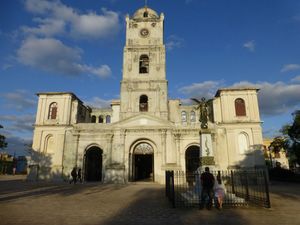

Iglesia de San José Church, Holguín
Enjoy the visit to the historic Iglesia de San José Church erected thanks to the effort of the people of Holguín.
Having a walk by the city center, you will find the charming Céspedes Park, the historical Iglesia de San José. It is one of the most significant buildings in Holguín and it goes back to colonial times.
Its creation is the result of the official recognition of Holguín as city in the year 1752. Consequent to this appointment, a group of Franciscan monks decided to move to Holguín with the aim of constructing a Franciscan convent in the city. The kind intention of the monks was to make the children literate and help the major priest with his tasks.
The first construction which took place was to erect a little hermitage where afterwards would be constructed the Iglesia de San José Church, since it was denied the authorization for building the convent. Finally, the church was given permission in 1803 but its construction did not begin until 1815, since it depended on the donations of the inhabitants. Finished in 1819, this church is one of the main monuments of the city for its architecture just as for its historic value.
Among the most outstanding facts, this church stands out because it is one of the fundamental points of the defense of the city by the Spanish Army, since it is located in the center of the city and was the tallest building back then, from where you could see any danger.
Regarding its architecture, the church you are currently seeing is far from its originary constructions. On the beginning it only had three naves; it want under a remodelling of the belltower in 1842, the only Neoclassica element maintained of the 19th century. Later on, in 1927, the clock was restored, located on the third level of the bell tower and was ordered to a prestigious German house. It was the first clock which counted the time in the city, the second one was set up in the Calixto García Park, in the tower of the current Martí Cinemas.
Once in the 20th century began the last enlargement of the church. By the end of the 30s, it was added at the back the houses of the priest and the curates, distributed among the spaces of the sacristy, enlarging the construction towards the sides and in two levels. In 1951 is constructed the current church, being left only the bell tower and some walls of the sacristy as 19th century works. The project was based, among other outstanding remodelings, on erecting in the cover of the presbytery an octagonal cupola with openings through which the outside light would get inside to highlight the images in the major altar.
Thus, you can see you are in a Neo-Classical temple inside the eclecticism, very characteristic of the Cuban art which is still worthy to admire. Do not hesitate in visiting the church linked to the legend of the Holguín lovers.
More information:
Location:
Plaza Carlos Manuel de Céspedes. Holguín, Cuba
Interactive map:
Holguín
What to see:
- San Isidoro Cathedral
- Julio Grave de Peralta Park
- Calixto García Íñiguez Park
- Iglesia de San José Church
- Casa Natal de Calixto García Birth House
- Carlos Manuel de Céspedes Park
- La Loma de La Cruz
- Finca Mayabe Ranch
- Gibara
- Batería Fernando VII
- Iglesia de San Fulgencio Church
- Bariay National Monument Park
- Poor Cinema International Festival
- Rocazul Biopark
- Guardalavaca
- Aldea Taína
- Banes
- Iglesia de Nuestra Señora de la Caridad Church
- Salto del Guayabo Waterfall
- Martí Park
- Cayo Saetía
- Naranjo Bay Natural Park
Beaches:
Museums:
Other nearby destinations:
Why "Trip Cuba"?
Trip Cuba is an organization of Cuban agencies whose objectives are:
- ✓ To make Cuba, its culture and its heritage known.
- ✓ To promote sustainable tourism.
- ✓ To support the local economy, prioritizing direct contact with Cuban agencies.
Travel Agencies
If you are a travel agency or tour operator and you are looking forward to any assistance or collaboration to plan trips to Cuba, rely on our extensive experience
Copyright www.TripCuba.Org © - All rights reserved
All our agencies are duly registered in the National Registry of Travel Agencies of the Chamber of Commerce of the Republic of Cuba.







